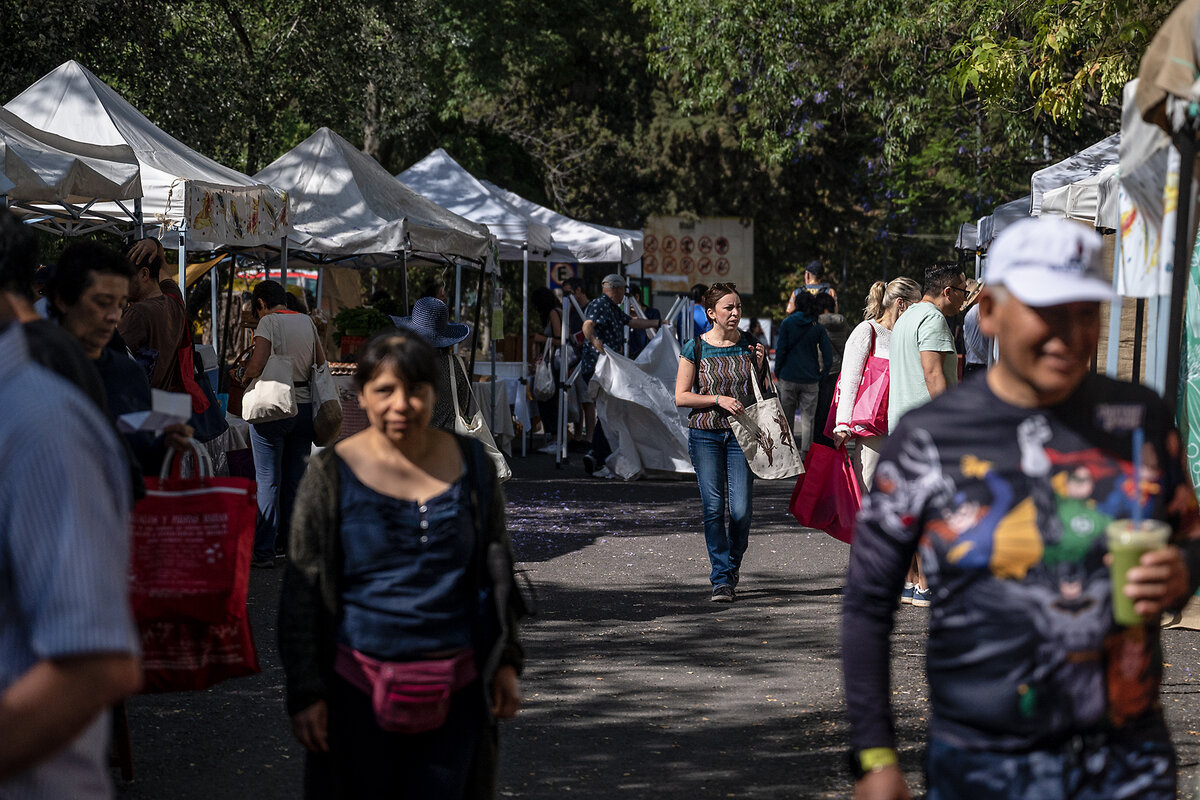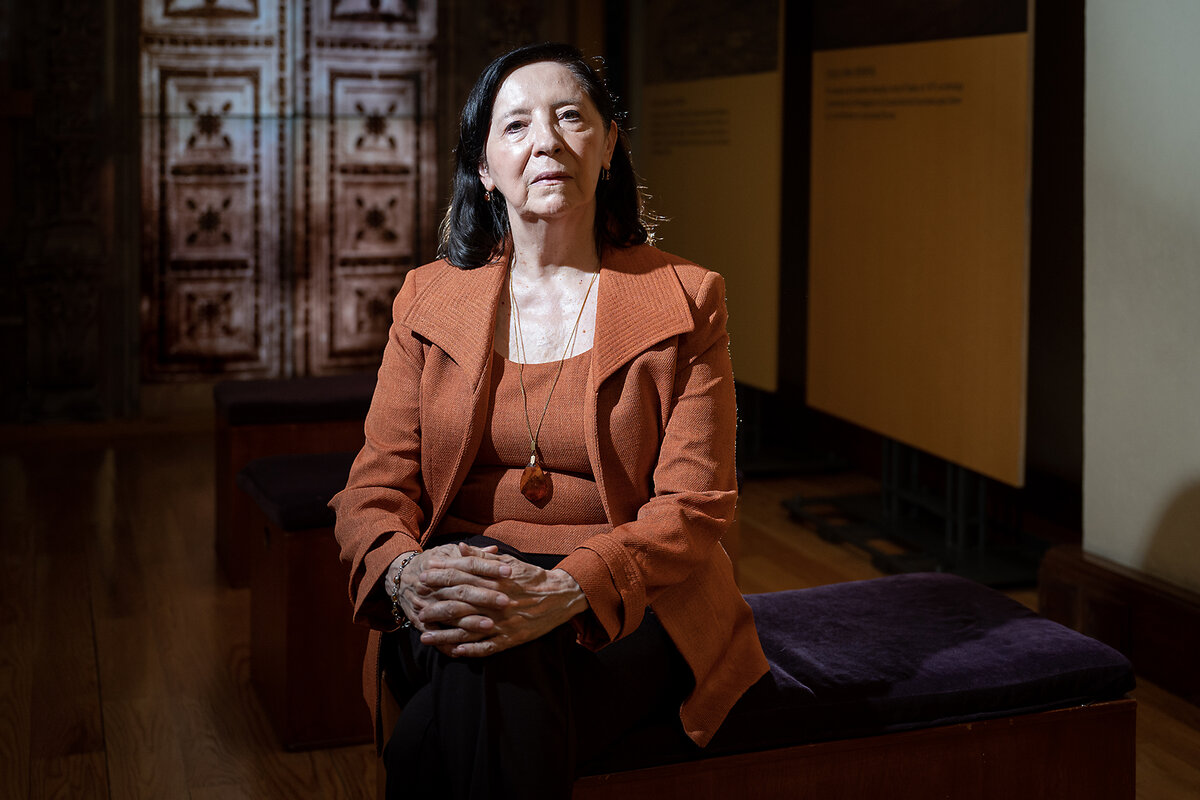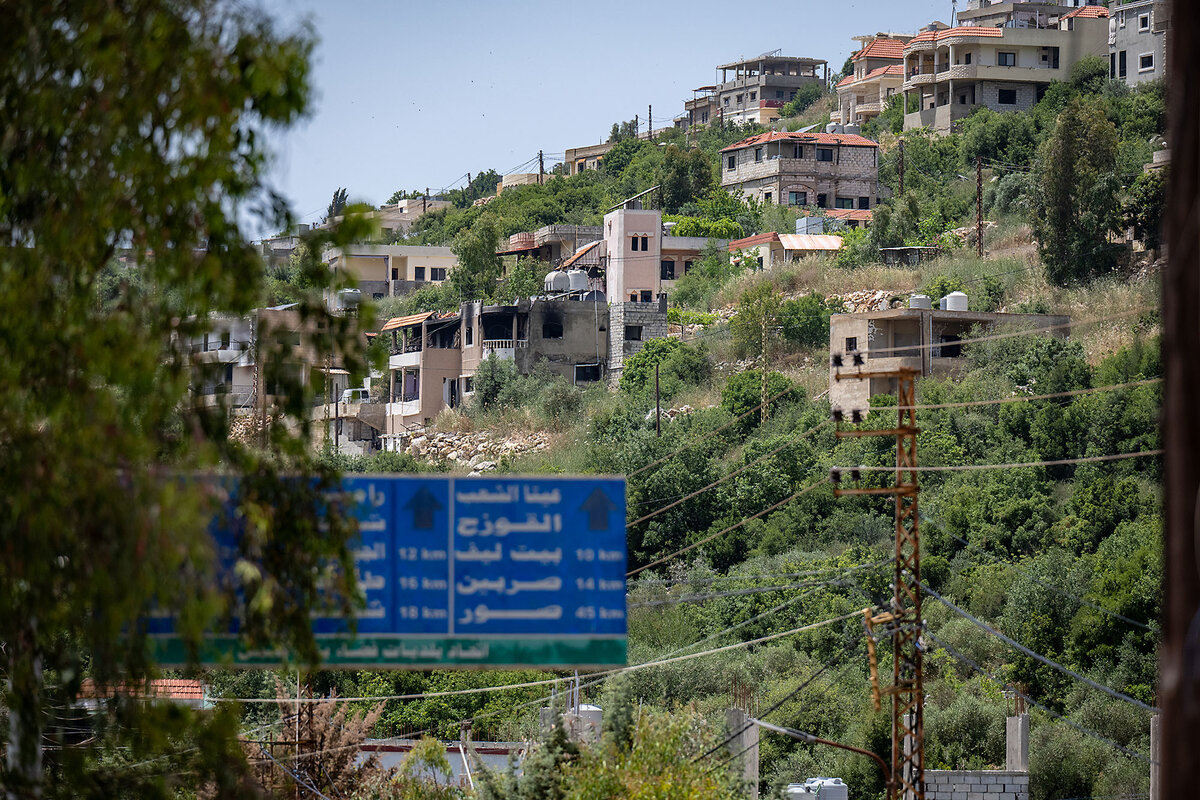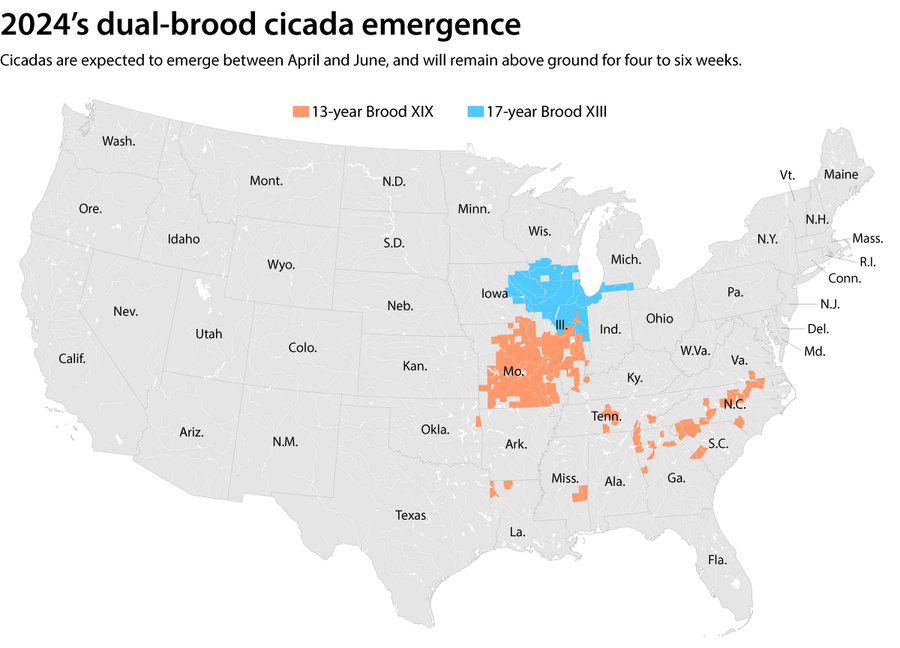- Quick Read
- Deep Read ( 16 Min. )

Why is Christian Science in our name?
Our name is about honesty. The Monitor is owned by The Christian Science Church, and we’ve always been transparent about that.
The Church publishes the Monitor because it sees good journalism as vital to progress in the world. Since 1908, we’ve aimed “to injure no man, but to bless all mankind,” as our founder, Mary Baker Eddy, put it.
Here, you’ll find award-winning journalism not driven by commercial influences – a news organization that takes seriously its mission to uplift the world by seeking solutions and finding reasons for credible hope.
Explore values journalism About usIn Today’s Issue
- Mexico’s election is about to shatter the ultimate glass ceiling
- Today’s news briefs
- To avoid war, Israel and Hezbollah shift their red lines. But war heats up.
- Trump trial: Not like OJ’s, but a media frenzy all the same
- A century of Border Patrol, from horses to AI
- Cicadas are out in the trillions and citizen scientists rejoice
Monitor Daily Podcast
- Follow us:
- Apple Podcasts
- Spotify
- RSS Feed
- Download
TODAY’S INTRO
Mexico’s moment
 Mark Sappenfield
Mark Sappenfield
Milestones are important. This weekend, when Mexico almost certainly elects its first female president, it will be historic.
But in a country that struggles with machismo and inequality, will electing a woman help? Studies show women excel at leading more inclusive governments, so maybe. But Whitney Eulich’s story today suggests another possibility.
Cultural change has led to this moment. Further cultural change is needed. But maybe that is more about the women in Whitney’s story than about the president. They and their predecessors have brought Mexico to this milestone. They will ensure it is a waymark, not an endpoint.
Share this article
Link copied.

Help fund Monitor journalism for $11/ month
Already a subscriber? Login

Monitor journalism changes lives because we open that too-small box that most people think they live in. We believe news can and should expand a sense of identity and possibility beyond narrow conventional expectations.
Our work isn't possible without your support.
A deeper look
Mexico’s election is about to shatter the ultimate glass ceiling
Mexican women have long struggled with their country’s culture of machismo. Now Mexico, ahead of the United States, is about to elect its first woman as president.

-
Riley Robinson Staff photographer
Mexico is known internationally for its machismo, a cultural emphasis put on stereotypical manliness and control. It permeates all parts of society. Violence and the number of women murdered with impunity continue to dominate the news – as well as perceptions of the country.
Now Mexico is on the cusp of electing its first female leader. Claudia Sheinbaum Pardo, the former mayor of Mexico City, is the front-runner for the June 2 vote. The hand-picked successor of outgoing populist President Andrés Manuel López Obrador, Dr. Sheinbaum is polling at roughly 59%. Former Sen. Xóchitl Gálvez Ruiz, the candidate who represents a coalition of three conservative opposition parties, is polling at 35%. These numbers all but guarantee that Mexico’s next president will be a woman.
It’s a stunning expression of women’s growing clout in Mexican politics. “This is going to be an incredibly important change,” says Patricia Galeana, a historian of gender in Mexico and former ambassador to Colombia. But, she warns, the stakes are high amid persistent inequalities and stubborn stereotypes about women in Mexican society.
“I hope that she has the position, but she also has the power,” she says.
Mexico’s election is about to shatter the ultimate glass ceiling
When Brenda Magaña Díaz was growing up in a working-class Mexico City neighborhood in the early 2000s, no one ever told her a woman could one day become president.
She had few obvious role models when she became one of six women in her graduating law school class. When she went on to work as a staffer at the Supreme Court and later for the president of the Mexican Congress, most of her colleagues were male.
On a recent day, Ms. Magaña, who now coordinates the “war room” of a candidate in Mexico’s upcoming presidential election, moves fast despite her stiletto heels, greeting a receptionist warmly as she heads upstairs and through a bright open room. A dozen young men and women are clicking away on their computers.
Her path to this point in her career may have been a lonely one – but it won’t be for girls growing up in 2024.
Julia Álvarez Icaza Ramírez came of age during the same era as Ms. Magaña, but in a middle-class Mexico City neighborhood. She didn’t have adults impressing upon her the possibility that a woman could be president, either. Growing up within Mexico’s burgeoning feminist movement, however, the young lawyer has focused her career on arguing for better gender perspectives in her country’s sentencing practices, a part of her wider commitment to restorative justice. Now Ms. Álvarez is putting that lens on the office of the president.
On another recent day, Ms. Álvarez is sitting in a spacious sound booth as part of a radio debate. In a circle of business suits and collared shirts, she wears an embroidered huipil, a traditional garment worn by Indigenous women, over her bluejeans. Amid tie clips and watches, she wears a delicate silver hoop glinting in her right nostril as she pleads her case for the leftist candidate she supports.

These two women hail from different ideological folds, but they are united in one effort: to see this macho country elect its first woman as president when it heads to the polls June 2.
Ms. Álvarez is a spokesperson for Claudia Sheinbaum Pardo, the former mayor of Mexico City and hand-picked successor of outgoing populist President Andrés Manuel López Obrador. Dr. Sheinbaum, who has a Ph.D. in energy engineering, is favored to win, polling at roughly 59%.
Ms. Magaña is the technical and war room coordinator for former Sen. Xóchitl Gálvez Ruiz, the candidate who represents a coalition of three conservative opposition parties, each with long histories in Mexico. Ms. Gálvez is polling at 35%. These numbers all but guarantee that Mexico’s next president will be a woman.
It’s a stunning expression of women’s growing clout in Mexican politics. But if the current contest is a visible example of that nascent political power, the foundations have been laid by women like Ms. Magaña and Ms. Álvarez and those before them. Like all those who fought, often invisibly, to get Mexico to this point, each woman continues to push against stubborn stereotypes and inequities.
“If I grew up believing power was only exercised by men, imagine a young girl who grows up during a woman’s presidency,” says Ms. Magaña. “Generations will start to see the world, possibilities, differently.”
Ms. Álvarez has been waiting her whole life for this.
“I was born ready for a woman president,” she says.

The road to parity
Mexico is known internationally for its machismo, a cultural emphasis put on stereotypical manliness and control. It permeates all parts of society. Violence and the number of women murdered with impunity continue to dominate the news – as well as perceptions of the country.
The National Autonomous University of Mexico is the first institution of higher education in North America, founded in 1551. But women weren’t granted access for another 300 years, a half-century after American women began to be accepted into colleges. Women gained the right to vote in 1953, three decades after U.S. women.
Mexican women’s historical exclusion from education, daily life, and politics traces back to the country’s long relationship with the conservative Catholic Church. For centuries the church dictated how and where women could move in public. During the Mexican Revolution, from 1910 to 1917, women bore arms and organized to end dictatorship and gain independence from the church. But they were denied suffrage afterward.
“It was argued that if they gave women the right to vote, they would undermine the revolution,” says Patricia Galeana, a historian of gender in Mexico and former ambassador to Colombia.
With the arrival of one-party rule in 1929, Mexican politics and culture were dominated by the Institutional Revolutionary Party (PRI) over the next seven decades. “In a single-minded culture, change is more difficult,” says Dr. Galeana.
Toward the end of the PRI’s grip on democracy in 2000 came not just a political but also a cultural opening that has buoyed women. Gender quotas were initially recommended in 1993, and by 2019 Mexico adopted a constitutional reform mandating “parity in everything,” including any public office. By 2021, the lower house of Congress was 50% women, and the president’s Cabinet has reached parity, too.
In April this year, Mexico’s legislature was ranked fourth globally in terms of women’s parliamentary representation. The United States is a distant 71st. Some 53% of Mexican men and 69% of Mexican women said they would prefer to have a woman as their next president, according to an Enkoll poll this February. They say they expect a woman to deal with issues like managing the economy and fighting corruption better than a male leader.

The candidates
On a recent weekday morning, Mexico City’s historic Zócalo plaza is flooded with vendors selling political trinkets plastered with the face of President López Obrador, whom people refer to as AMLO. Part of the Morena political party, his government has overseen one of the bloodiest periods in Mexican history, with nearly 30,000 murders annually over the past five years. Yet his approval ratings remain above 60%, and that has bolstered his party’s candidate, Dr. Sheinbaum, whose face appears sprinkled among piles of stuffed AMLO dolls, oven mitts, and keychains.
Dr. Sheinbaum is seen as the continuation of AMLO’s policies and his project to transform the nation. That means she’s expected to continue supporting austerity measures, vast infrastructure projects, and the newly created National Guard. But the climate scientist and granddaughter of Jewish immigrants says she’ll put her own imprint on Morena policies, including lessons in crime reduction she learned as Mexico City mayor from 2018 to last year.
Ms. Gálvez’s image is not nearly as ubiquitous. The candidate of the conservative coalition grew up selling gelatin treats on the street in her home state of Hidalgo and went on to study engineering, becoming a tech entrepreneur. Her father was an Indigenous Otomi schoolteacher, and by her account, physically and emotionally abusive. She entered public office in 2000 to run the Indigenous Peoples’ Development Office under then-President Vicente Fox.
Her platform includes raising taxes on Mexico’s wealthy people, creating a national child care system, opening the state-run oil company to foreign investment, and doubling down on the use of the military to fight organized crime.
Although both candidates found themselves tripping over each other in the first presidential debate in April, agreeing on liberal policies like protecting the human rights of transgender populations, their political affiliations are lightning rods for division, especially along socioeconomic lines.

This polarization has in some ways overshadowed the excitement of the prospect of electing the country’s first female leader. Still, having a woman as president of Mexico will only help to empower women, observers say.
“This is going to be an incredibly important change,” says Dr. Galeana, who warns the stakes are high. “What I hope from the next president is that she isn’t a Juanita,” says Dr. Galeana. A disparaging expression, “a Juanita” refers to a hypothetical woman who would win an election after the country introduced its gender quota requirements. But after winning, she would immediately step down so a man could be appointed to take the office instead.
“I hope that she has the position, but she also has the power,” she says.
Proving themselves
Indeed, both candidates have been dismissed as “puppets” of men. AMLO critics say Dr. Sheinbaum was selected because she proved loyal. The implication is, she’s only in the race because AMLO can control her to do his bidding. (Mexican presidents serve only one term.)
Ms. Gálvez has also been called a “token,” a candidate for a coalition of three deeply entrenched and formerly opposing political parties that are each led by men.

Standing in the shadow of Mexico City’s iconic Angel of Independence monument, Rolando Ortiz Peon dismisses the idea that sexism is behind all the national chatter that the candidates only stand in the shadow of men. Wearing a campaign T-shirt that reads, “Xóchitl for President: For a Mexico without fear,” he says, “The fact that people are pointing to Claudia or pointing to Xóchitl and calling them puppets is more about political polarization than machismo.”
His wife, Maria Estella Sánchez Rojas, interjects. The two have just finished a group bike ride in which participants handed out “Xóchitl” stickers throughout the city. (The candidate Ms. Gálvez often arrives at her events riding a bicycle.) “It is sexist to paint a woman in power as only being there because she’s manipulated by a man,” she tells her husband. One effect of the prevalence of machismo in Mexico, she says, is that “many women buy into the misogyny. They might even worsen it.”
Despite the explosion of political representation among women, this presidential campaign has underscored the work that still must be done. Both candidates have defended their qualifications to run as media tropes and polling questions ask if macho Mexico “is ready” for a woman.
Ms. Gálvez wrapped up a speech last fall about her plans for fighting violence in the country by saying she has “the ovaries” to fight criminals and assuring voters that she’s “not afraid.”
Dr. Sheinbaum has told crowds that Mexico has women engineers, firefighters, and deputies, as if convincing voters of the nation’s preparedness for a woman as president is a necessary part of her platform. AMLO defended her qualifications this spring in an interview, saying, “She is more prepared than I am.”

For generations women have been entering Mexico’s business and political communities, if slowly and often behind the scenes. But as their numbers began to grow, and as more women helped others navigate their way, attitudes began to slowly change as they countered their country’s deeply rooted machismo.
Women helping women
María Lucero Saldaña Pérez was first elected to public office right out of college in the 1980s, before the introduction of quota requirements. She often heard comments about how she should be putting her energy into raising her children and supporting her husband instead of working in Congress. She’s spent much of her career, in fact, trying to mentor other women in politics, from newly elected mayors to city council members to congresswomen.
“The tools for opening doors into politics are important,” says Dr. Saldaña, who currently serves as a municipal secretary in the capital of Puebla state. The quota systems were important, “but we also need training and support” to further build the rosters of female leaders.
Karina Ojeda Valle, who built her career in the private sector, says women in politics and business are dealing less with glass ceilings and more with “sticky floors” these days. They’ve got a foot in the door, she says, but now face barriers to advancement.
“For so many years I felt totally isolated in my field,” says Ms. Ojeda, who founded the group Women Investing. In 2022, she also launched an annual summit called Decididas, or Determined, which brings together women across 30 industries to trade ideas, provide support, and celebrate victories – like the imminent election of Mexico’s first woman president.
“Finding a sorority in the same industry [showed me] there are so many who are fighting for the same things,” Ms. Ojeda says.
The growing business and political power of Mexican women has had a profound effect on policy. In just the past few years, Mexico’s Supreme Court, which is headed by a woman, decriminalized abortion. (The government also introduced the first feminist foreign policy in the Global South, which means setting policies from parity to international cooperation through a gender perspective.)
Ms. Álvarez was helped by Dr. Sheinbaum even before she became her spokesperson, she says. On this day she’s strolling through the bustling farmers market she founded almost a decade ago in this southern borough of Mexico City. Again wearing a traditional huipil and bluejeans, she struggles to go 5 feet without a vendor stopping her for a hug or update.

Her farmers market, and her role as a part-time spokesperson, are in many ways side jobs as she continues to work full time at the Gender Studies and Research Center at the National Autonomous University of Mexico.
She first met Dr. Sheinbaum nine years ago when the politician was mayor of Tlalpan, a borough of cobblestone streets. Ms. Álvarez, passionate about food systems, wanted to connect local farmers with her community. The candidate she now works for helped her find a physical space to launch the market, Mercado Alternativo de Tlalpan, which has gone from a handful of producers to more than 100 over the past decade.
She aspires to make a more equal Mexico one day by becoming a judge, Ms. Álvarez says. She sees parallels between her own goals and what Dr. Sheinbaum stands for. “She’s not your typical politician. She’s grounded, and she always tries to maintain direct contact with the people.”
Ms. Magaña, the war room coordinator, says it was her mother who helped propel her political career. She had pulled herself up from poverty even though she had to drop out of school when she became a young mom. Together they moved from home to home until Ms. Magaña’s mother was eventually able to study law online, buy an apartment, and launch a small real estate business. That’s why the life story and candidacy of Ms. Gálvez speaks so much to her.
“She’s a woman who pulled herself up,” says Ms. Magaña as she races between teaching law at her alma mater and then rushing back to her office. She’s answering calls from colleagues on speakerphone as she maneuvers deftly through the capital’s traffic. “And this has made her so empathetic and understanding of all the problems that exist in Mexico.”
Having a woman president doesn’t guarantee feminist policies or concrete changes for women, both political advocates agree. But the fact that the next president of Mexico will be a woman was only made possible by decades of protest, new policies, and cultural shifts that paved the way to this election.
The role of feminism
A young boy and his mother are lingering in a room dedicated to liberty and education at the Museo de la Mujer, or Museum of the Woman, in Mexico City’s historic center. They look at the replica of the doors to the first university in Latin America, and the boy is considering writing about its exclusion of women for a primary-school history project.
“A woman president is going to be special,” the boy says. “It’s the next thing we’ll see in this museum.”

Housed inside an old university printing press and founded in 2011 by Dr. Galeana, the gender historian, the Museo de la Mujer also displays a poem by María Griselda Álvarez Ponce de León, who in 1979 was elected the first woman state governor in Mexico. The poem, too, is titled “Mujer.”
“Being born a woman is an immense challenge,” it begins.
As women and others celebrate what is certain to be the election of the first woman to hold the office of president, the poem expresses caution, and reminds mujeres of the struggles that still lie ahead.
During her campaigns decades ago, the late politician and poet was told that her constituents weren’t ready for a woman in charge. But Ms. Álvarez (no relation to the spokesperson) proved herself as a governor, establishing a long list of statewide legacies that include building the legislative and judicial buildings in Colima, instituting a host of museums, and establishing a number of women’s shelters. She also told women with high aspirations in business or politics to never get married if they wished their careers to shine.
You bleed before the law with every battle ...
Soft outside, deep inside you’re oak.
But in beating you down, they make you a feminist!
Since her time in office, Mexico’s formidable and growing feminist movement has helped bring the country to this political moment. Today feminist groups meet regularly on college campuses and in office lobbies in ways they hadn’t before.

They also take to the streets every March 8, International Women’s Day, and this year Mexico’s capital is flooded with purple. With the city’s iconic jacaranda trees in full bloom, tens of thousands of violet-clad women are marching down the city’s thoroughfare, demanding equality and security.
The demonstrations have grown each year. In 2021, activists placed an unsanctioned “guerrilla” statue of a purple woman with her left fist raised above her head on the Paseo de la Reforma, one of the oldest thoroughfares in Mexico City, replacing a statue of Christopher Columbus that once stood on a tall column at a roundabout. Now named Justicia, it is dedicated to women who were murdered or who disappeared. Mexico City officials agreed not to take down the new statue, a prominent feature of the march route. The former Columbus roundabout, too, has been renamed Glorieta de las Mujeres que Luchan, or the Roundabout of Women Who Fight.
On the bright spring day this year, teens in crop tops are singing, “It wasn’t my fault, where I was or how I was dressed.” Mothers and grandmothers are walking with the younger generations.
Melissa Ruiz de la Peña, her daughter, and her niece are marching together, wearing purple bandannas and carrying signs that read, “Your ‘jokes’ aren’t funny” and “If you saw the world through our eyes, you’d be screaming too.”
Ms. Ruiz says a lot has changed since her youth. The bank she worked for said her lower salary was justified because she wasn’t “supporting a family” as head of a household like her male colleagues, she recalls. Never mind she had two children at home.
Although Ms. Ruiz acknowledges Mexico’s first woman president is a breakthrough, she also worries it could negatively impact how women in power will be perceived afterward. That includes “what’s sure to be an extremely high bar” for the first woman president’s performance, she says.

A new cultural foundation
On a recent afternoon of record high heat in Mexico City, Ms. Álvarez is sitting at her computer fuming.
She’s just wrapped up a live radio debate on a national broadcast. Ms. Álvarez is participating in the radio debate every week for the duration of the campaign, representing the perspective of Dr. Sheinbaum. She’s been debating with spokespeople from the other two campaigns, including the spokesperson for Jorge Álvarez Máynez of Movimiento Ciudadano, the lone male candidate, who is polling a distant third.
Ms. Álvarez was about to discuss how her candidate would finance her presidential proposals. Instead, she spent the 30-minute program getting interrupted and spoken over by a well-known politician who is representing Ms. Gálvez in the debate. Even producers in the control booth quipped about implementing time limits for future recordings of this program.
“By the end I was so angry, I couldn’t even hear him anymore,” says Ms. Álvarez. “As women, we’re conditioned not to interrupt. And then the one guy in the room plays by his rules and takes up half the airtime,” she says, exasperated.
Ms. Magaña sometimes feels silenced, too. In March she stood behind a podium at the Escuela Libre de Derecho, a small law school with graduates who have become important political figures, including presidents. She was there to talk about Women’s History Week.
Although she arranged for a high-profile government minister to speak to the students, she herself wasn’t invited to be a part of the event. “I really pushed for a chance to speak,” she says. In the end, she gave a moving introduction about the importance of having women in powerful positions, a reminder of the historic debt Mexicans owe the trailblazers before them.
Carving out space for herself as a woman is a skill she endlessly hones. Every morning at the campaign office, she sits at a long, U-shaped table among a dozen established, mostly male politicians and strategists. Even though it is Ms. Gálvez’s war room, she is slowly, but increasingly, starting to share her own ideas and opinions, she says.
After generations of maneuvering and fighting for change, Mexican women say what they are most hoping for in this historic vote is a deeper cultural change.
“Modifying laws, modifying public policy, that all takes work,” says Dr. Saldaña, the politician in Puebla. “But modifying stereotypes, prejudices, myths, and this entire system of belief around what [a woman can or should] do is more complicated. It means modifying culture.”

Today’s news briefs
• Ukraine aid: Ukrainian President Volodymyr Zelenskyy receives a second $1 billion promise of military aid in as many days during a tour through the European Union.
• Taiwan changes: Taiwan’s legislature passes changes that are seen as favoring China and diminishing the power of the island’s president.
• Palestinian state: Spain, Ireland, and Norway formally recognize a Palestinian state to put international pressure on Israel to soften its response to last year’s Hamas-led attack.
• Soccer players quit: Three players quit Argentina’s national women’s team after a dispute with soccer organizers over a lack of pay and poor conditions.

To avoid war, Israel and Hezbollah shift their red lines. But war heats up.
On the Israel-Lebanon border, old adversaries Israel and Hezbollah know each other well, and what triggers the other. Since Hamas’ attack on Israel, the two sides have sought to avoid a full-scale war even as they appear to move closer to it.

- Quick Read
- Deep Read ( 5 Min. )
From a U.N. base in southern Lebanon, the click-whoosh can clearly be heard of Hezbollah rockets fired toward Israel. Within minutes, Israel responds with artillery rounds that whistle to their target and explode – the latest of some 13,000 projectiles the United Nations says have flown back and forth across this border in the previous month.
The escalation between Hezbollah and Israel along the Lebanon-Israel border has surged into a hot war since Hamas’ Oct. 7 attack on Israel. What constitutes an action that would trigger an all-out war has evolved beyond recognition. Analysts say there is no obvious off-ramp, as long as the war in Gaza continues without a cease-fire – Hezbollah’s condition for calming this border.
“The red lines still exist, and they still matter. ... But we have also seen a willingness on both sides to tolerate the violation of previously accepted red lines,” says David Wood, senior Lebanon analyst for the International Crisis Group.
“That is not a safe basis to continue on. It’s better than both sides flying off the handle, but every single one of these operations risks breaching a red line – or one party changes its mind, and says we are no longer willing to accept these kinds of violations,” he says. “It’s incredibly dangerous.”
To avoid war, Israel and Hezbollah shift their red lines. But war heats up.
Overlooking an Israeli surveillance tower and a security fence that snakes inland from the Mediterranean, the watchtowers of the United Nations peacekeeping mission in Lebanon provide a front-row seat to one sliver of the escalating fight between Hezbollah and Israel.
On a recent afternoon, hot and with little sea breeze, the click-whoosh can clearly be heard of rockets fired toward Israel, from nearby stony ground thick with high scrub, by the Iran-backed Shiite Hezbollah militia. Within minutes, Israel responds with artillery rounds that whistle to their target and explode, just over the hill – the latest of some 13,000 projectiles the U.N. says have flown back and forth across this border in the previous month.
Shrapnel from previous rocket duels overhead has impaled solar panels here at the headquarters of the U.N. Interim Force in Lebanon (UNIFIL). Toward the west, amid a steady buzz of Israeli drones, swaths of low-forest cover have been burned by Israeli phosphorus munitions.
Precision can be highly effective: Closed-circuit TV footage shows a motorcycle in recent days taking a direct hit, presumably fired by an Israeli drone against a Hezbollah operative, as it passed just feet away from the UNIFIL compound’s wall.
The escalation between Hezbollah and Israel along the Lebanon-Israel border has surged into a hot war since Hamas’ Oct. 7 attack on Israel. In support of Hamas, Hezbollah began to strike Israeli targets, in a series of escalating tit-for-tat exchanges.
What constitutes an action that would trigger an all-out war has evolved beyond recognition. Analysts say there is no obvious offramp, as long as the war in Gaza continues without a cease-fire – Hezbollah’s condition for calming this border.

A critical framework may be U.N. Security Council Resolution 1701, which in 2006 codified a cease-fire agreement that ended a monthlong war between Hezbollah and Israel but has never been fully implemented.
“The red lines still exist, and they still matter, and they are still important. But we have also seen a willingness on both sides to tolerate the violation of previously accepted red lines,” says David Wood, the Beirut-based senior Lebanon analyst for the International Crisis Group.
“That is not a safe basis to continue on. It’s better than both sides flying off the handle, but every single one of these operations risks breaching a red line – or one party changes its mind, and says we are no longer willing to accept these kinds of violations,” says Mr. Wood.
“It’s incredibly dangerous,” he adds. “The only safe way to manage this conflict is starting with a cease-fire in Gaza, but also a cease-fire at the border. Everything else is just damage limitation.”
While both sides have so far kept within newly expanding parameters, in clear efforts to avoid a broader war, the risks of miscalculation – and its devastating results – could not be higher.
Indeed, Hezbollah has barely scratched the surface of its arsenal, estimated at 150,000 rockets and missiles. Hezbollah leader Hassan Nasrallah warned last month that Israel had so far not seen “anything” of its capabilities.
And Israel has mounted a challenging invasion of Gaza that has absorbed the focus of its military, leaving little room or appetite right now for another full-blown war against Hezbollah.
“The fundamental difference is that Israel has repeatedly tried to assert that these are separate battlefronts, and will be dealt with separately,” says Mr. Wood.

“Hezbollah’s fundamental pledge is that, as long as there are atrocities being committed in Gaza, and as long as – in their view – Hamas needs Hezbollah, Hezbollah will not stand down at the border [or] enter into discussions about ‘the day after,’” says Mr. Wood.
So far, parallel diplomatic efforts by the United States and France since October to find a formula that calms this border have born little fruit. Some 90,000 civilians have moved away from the Lebanese side to safer areas, while some 60,000 Israeli civilians have been evacuated from northern Israel.
“The rhetoric is very high, but the reality is different,” says Andrea Tenenti, the spokesperson for UNIFIL, which has more than 10,000 blue-helmet troops from nearly 50 nations stationed in a border region south of the Litani River. All told, it accounts for 10% of Lebanese territory, and is packed with villages and towns, most of them with Shiite populations that support Hezbollah.
“Nobody really wants to start a wider conflict, but after seven months, the potential for a huge miscalculation – the potential for a larger escalation – is around the corner,” says Mr. Tenenti. “We can’t anymore think that this can continue forever.”
Resolution 1701 may be a critical framework for an eventual deal, and not just because it demands that both sides stop cross-border exchanges of fire. It also requires Hezbollah to pull back north of the Litani – a requirement that Hezbollah in recent years has brazenly flaunted, not only with weapons, but also by setting up firing ranges and observation posts near Israeli forces.
Israel is also meant to respect Lebanese sovereignty, but for years and almost daily has conducted military flights over and through Lebanese airspace, and moved into or held pieces of territory claimed by Lebanese.

Prior to October, progress had been made on seven out of 13 of Lebanon’s outstanding grievances. And UNIFIL facilitated more than 150 meetings since 2006 to de-escalate tensions, during which a senior Israeli officer sat at the same table as a Lebanese army officer on the border.
“There is no military solution; there is only a political and diplomatic solution to this conflict,” says Mr. Tenenti, noting that Hezbollah is significantly stronger than Hamas.
“There is not much that anyone can do until there is a clear solution in Gaza,” he adds. “This is the first time that we have a conflict here that has been triggered by something else. So it can’t only be controlled between Lebanon and Israel; it has to be solved somewhere else first.”
The transformation has been clear: “Before [October] if just one rocket was launched into Israeli territory, and retaliation, that could have definitely triggered a larger conflict. Now we are seeing thousands and thousands of trajectories, and you can see no one wants to start a [full-blown] conflict,” says Mr. Tenenti.
In the meantime, it is not clear how long both sides can continue to maintain the current escalatory equilibrium, such that more and heavier rockets and missiles reach deeper and deeper into each country.
“In some ways, it’s like asking someone playing Russian roulette how confident they are that they are not going to lose,” says Mr. Wood, the analyst. “Do I think it is on that level of risk? No. But equally, I can’t say ... the front on the south Lebanon border can continue for months, and there won’t be a disastrous expansion of the war.”

Trump trial: Not like OJ’s, but a media frenzy all the same
Nonstop media coverage could help shape how the hush money trial of Donald Trump is ultimately perceived by the public – even if it’s not a “trial of the century.”

- Quick Read
- Deep Read ( 5 Min. )
Former President Donald Trump’s New York criminal trial has featured gripping, and at times steamy, testimony from a former tabloid publisher on the secrets of his business, a porn star on her alleged tryst with Mr. Trump, and a former Trump lawyer on how his boss allegedly paid to silence the porn star.
For media outlets, the result has been a monthlong stream of content for readers and viewers – despite the fact that, at heart, the case is about the falsification of business records. By all accounts the jurors, too, have paid rapt attention.
But while the Trump case has generated heavy coverage on cable news and in social media, it has not risen to “trial of the century” levels, comparable to the 1995 O.J. Simpson trial. A recent Yahoo News/YouGov poll found that only 16% of respondents said they were following the trial “very closely.” Another 32% said they were following it “somewhat closely.”
One factor: Unlike Mr. Simpson’s trial for murder, this one has no cameras in the courtroom. The news from Mr. Trump’s trial is based on reports from journalists in the room.
Trump trial: Not like OJ’s, but a media frenzy all the same

Former President Donald Trump’s New York criminal trial has featured gripping, and at times steamy, testimony from a former tabloid publisher on the secrets of his business, a porn star on her alleged tryst with Mr. Trump, and a former Trump lawyer on how his boss allegedly paid to silence the porn star.
For the media outlets reporting on every twist and turn, the monthlong event has provided a steady stream of content for readers and viewers – despite the fact that, at heart, the case is actually about the falsification of business records. By all accounts the jurors, too, have paid rapt attention.
But while the Trump case has generated heavy coverage on cable news and in social media, it has not risen to “trial of the century” levels, comparable to the O.J. Simpson trial. Indeed, a recent Yahoo News/YouGov poll found that only 16% of respondents said they were following the trial “very closely.” Another 32% said they were following it “somewhat closely.”
There have been no large-scale demonstrations or altercations outside the courthouse. Outbursts inside have also been limited.
One reason it did not become the O.J. Simpson trial may be because New York law prevents cameras inside the courtroom. Former NFL star O.J. Simpson’s 1995 trial for the murder of his ex-wife Nicole Brown Simpson and her friend Ronald Goldman was carried live on TV, and generated historic levels of audience and media interest. By contrast, the cable news analysts parsing every new development in Mr. Trump’s legal proceedings have had to do it based on secondhand reports from journalists in the room.
“Without the cameras in the courtroom, the trial averted some of the spectacle and theatrics of a televised trial like the O.J. Simpson case,” says Roy Gutterman, director of Syracuse University’s Tully Center for Free Speech, in an email.
Chaos and the defense
In closing arguments on May 28, the defense went first. Then the prosecution attempted to convince 12 jurors that Mr. Trump falsified business records to cover up his alleged affair with porn star Stormy Daniels because he was worried that if it became public, it would damage his chances in the 2016 presidential election.
Mr. Trump has denied the affair with Ms. Daniels, as well as all other charges. His defense argued that the central figure in the prosecution’s case, former Trump lawyer and fixer Michael Cohen, is a proven liar whose testimony cannot be trusted. Mr. Cohen was the only witness to tie Mr. Trump directly to payments to Ms. Daniels, though circumstantial evidence did point to the former president’s involvement.
The prosecution has the higher bar to clear, given that it must prove guilt beyond a reasonable doubt. That means it must convince jurors of a narrative that explains what happened.
The defense does not have to offer an alternative story. It simply must convince the jury that reasonable doubt about the prosecution’s case remains. Defense attorneys can throw any number of hamburgers against the wall to see if any ketchup sticks. Their argument does not necessarily have to be coherent.
“Chaos, unpredictable things, things that are not related to proof of guilt generally favor the defense,” says Dilan Esper, a 29-year civil litigator in California.
Media coverage is one of those unpredictable things. Reporters want stories, and their efforts can sometimes upend prosecution plans. In the O.J. Simpson trial, prosecutors had a witness ready to testify that she saw the ex-football star driving fast and erratically outside his ex-wife’s home around the time she was killed. But she sold her story for $5,000 to the tabloid TV show “Hard Copy,” and lead prosecutor Marcia Clark decided she was too tainted to put on the stand.
As far as we know, nothing like that has occurred in the Trump trial. But the former president and his attorneys have followed a strategy of trying to create as much news as possible, in part because they know reporters will eat it up. Thus the daily displays of Republican officials, including House Speaker Mike Johnson, showing up in court to support Mr. Trump and hold their own press conferences.
Mr. Trump’s insistence that he would testify – though he didn’t in the end – may also have been a calculated move. Perhaps Mr. Trump really did want to take the stand. But in many big trials, defense attorneys tell the media that the defendant is considering speaking under oath. It forces prosecutors to waste time preparing for something the defense knows isn’t going to happen.
The media can’t help but report the “may testify” gambit as news. “In fact, [they’re] being played,” says Mr. Esper.
Drama and ratings
The Trump criminal trial has produced a number of dramatic courtroom moments. Ms. Daniels’ pointillistic recounting of her alleged Trump tryst – she recalled the shampoo in his bathroom was not just Pert, but Pert Plus – stilled the audience, according to reporters who were there. The cross-examination of Ms. Daniels was tense as defense lawyers tried to portray her as a money-driven opportunist.
Mr. Cohen’s turn on the stand was grueling, stretching over days. At one point, a defense attorney was shouting at him as they questioned whether he had really talked with Mr. Trump about payments to Ms. Daniels. Mr. Cohen remained largely composed, and it remains to be seen how the jury interpreted this key testimony.
For sheer drama, the most memorable moment was perhaps a May 20 incident that revolved around lawyer Robert Costello.
It began when Judge Juan Merchan took umbrage at what he felt was Mr. Costello’s impudence on the stand concerning overruled objections by the defense.
“When there is a witness on the stand, if you don’t like my ruling, you don’t say ‘jeez,’ OK?” said the judge with uncharacteristic fire.
Judge Merchan then tried to clear the court so he could rebuke Mr. Costello. But the media didn’t want to go.
“This is an open courtroom. It is open to the people, open to the public. You can’t throw us out!” said one journalist, unnamed in the official court transcript.
A press lawyer got involved. Judicial staff kept politely pushing. Eventually, they moved the audience into a hallway.
“Let the record reflect ... that the court officers had great difficulty clearing the courtroom, because the courtroom is made up, primarily, of the press,” Judge Merchan said.
At the end of the O.J. Simpson trial, 150 million people tuned in to watch the verdict live.
By contrast, Americans will not be able to see the verdict being read from the New York courtroom where the Trump trial is playing out.
When the verdict comes down, as throughout the trial, the public will be relying on reporters and commentators, “who did a commendable job of delivering detailed coverage and analysis,” says Professor Gutterman, himself a former reporter.
Still, no description or report is the same as seeing things live on television – and some observers say that may have been to the detriment of the American people in this case.
“There would have been significant problems and risks of things getting out of control had this case been televised,” says Professor Gutterman. “But I still believe open courts is important to facilitating the public’s understanding of the law and criminal justice.”
Editor's note: As closing arguments in the trial occurred, two paragraphs in the story were updated to reflect that.

The Explainer
A century of Border Patrol, from horses to AI
The U.S. Border Patrol turns 100 this week. How has the agency changed over time and what role does it play now in an election year when border security is of high voter interest?

- Quick Read
- Deep Read ( 4 Min. )
-
Caitlin Babcock Staff writer
The Border Patrol celebrates its centennial on May 28. Its evolution in technology, staffing size, and methods has tracked the changing politics and priorities of the United States.
The agency remains in the news today, given record levels of illegal immigration and voter attention on border security in the 2024 presidential election.
The agency patrols 6,000 miles of U.S. land borders with Canada and Mexico between ports of entry, along with 2,000 miles around the coasts of Florida and Puerto Rico. A typical agent’s day might include surveillance, apprehensions, or on-the-ground detection strategies aimed at finding people and goods that have crossed without permission.
Staffing levels grew from just over 4,000 agents in 1992 to nearly 19,000 today. Technology such as mobile sensors and drones also transformed work in the field. An expansion of artificial intelligence may mark a new era.
Like U.S. law enforcement more broadly, the Border Patrol has long grappled with political and professional scrutiny.
Revelations of some agents’ racist vitriol toward migrants, along with allegations of sexual misconduct against women employees, have rocked public trust in recent years. “We do not tolerate misconduct within our ranks,” a Customs and Border Protection spokesperson says in an email.
A century of Border Patrol, from horses to AI
The first U.S. Border Patrol agents were paid about $30,000 in today’s dollars and supplied their own horses and saddles. Washington paid for oats and hay.
The Border Patrol still uses horses, sometimes controversially – as well as all-terrain vehicles, trucks, and boats. As the agency turns 100 years old in May, its evolution in technology, staffing size, and methods has tracked the changing politics and priorities of the country.
The Border Patrol remains in the news today, given record levels of illegal immigration and voter attention on border security in the 2024 presidential election.
What does the Border Patrol do?
The agency patrols 6,000 miles of U.S. land borders with Canada and Mexico between ports of entry, along with 2,000 miles around the coasts of Florida and Puerto Rico. A typical agent’s day might include surveillance, apprehensions, or on-the-ground detection strategies aimed at finding people and goods that have crossed without permission.
The Border Patrol recorded more than 2 million encounters at the U.S.-Mexico border for each of the past two fiscal years, though a dip in illegal crossings this spring bucks a seasonal trend. Many individuals are fleeing persecution or are economic migrants – and are taken advantage of by criminal groups that coordinate illegal crossings, Border Patrol Chief Jason Owens told CBS News in March.
Aiding and processing these individuals, en masse, distracts the Border Patrol from potential criminals or illegal drugs evading detection, Chief Owens said.
Beyond the detection of illegal immigration and the processing of migrants, the Border Patrol seizes contraband, such as drugs. (Most drugs, however, are seized at ports.)
The Border Patrol also mobilizes to save the lives of migrants found in distress, such as from heat exposure. The agency reported last fiscal year the rescue of 37,324 people along the southern border. For fiscal year 2022, the government also reported 139 deaths linked to Border Patrol operations, with the largest share attributed to medical distress.
“A lot of folks don’t, I think, fully understand the job of a United States Border Patrol agent,” Chief Owens told CBS. “They’re more than just law enforcement.”
Chief Owens is currently under investigation by Customs and Border Protection for potential ethics violations over his relationship with a Mexican businessperson, reports NBC News.
“CBP has confidence in our senior leaders and holds them to the highest standards of integrity and professionalism,” a spokesperson wrote in an email to the Monitor.
How has the agency changed?
Beginning in the late 1800s, the U.S. started to cement its federal role over immigration. The nation began enacting restrictive laws that barred Asian immigrants and set quotas for others.
This new era put the “federal government in a position where they now actually have to enforce that law,” says Alan Capps, an adjunct professor of history at George Mason University.
Precursors to the Border Patrol included mounted guards and inspectors. “In 1924, there was already a really strong federal presence along the border,” says Jim Dupree, history lecturer at the University of Texas Rio Grande Valley.
The first federal Border Patrol, formed in 1924 through new funding for the Department of Labor, focused on patrolling U.S. borders in search of migrants. Early agents included former Texas Rangers.
World War II cued a new chapter: In 1940, the agency transferred to the Department of Justice. The Border Patrol guarded camps that detained Japanese Americans and immigrants – camps that the government later apologized for.
Border enforcement evolved over decades alongside immigration policy. The 1990s saw a hardening of the southern border aimed at curbing illegal immigration, a crackdown led by then-President Bill Clinton. Following 9/11, Congress created the Department of Homeland Security. This new entity established Customs and Border Protection, which oversees the Border Patrol. Agents’ focus expanded to include preventing terrorism.
Border policy has fluctuated sharply between the Trump and Biden presidencies. Yet Border Patrol agents under both administrations expelled asylum-seekers and other migrants during the pandemic due to a public health policy.
Staffing levels grew from just over 4,000 agents in 1992 to nearly 19,000 today. Technology such as mobile sensors and drones also transformed work in the field. An expansion of artificial intelligence may mark a new era.
How is the Border Patrol perceived?
Like U.S. law enforcement more broadly, the Border Patrol has long grappled with political and professional scrutiny. As of 2019, about 37% of voters surveyed in southwest border states had little or no trust in the Border Patrol to “protect the rights and civil liberties” of everyone equally.
Revelations of some agents’ racist vitriol toward migrants, along with allegations of sexual misconduct against women employees, have rocked public trust in recent years. In 2021, the agency stopped using horses in Del Rio, Texas, after photos surfaced of mounted agents charging at Haitian migrants.
Immigrant advocacy groups like the Kino Border Initiative, which operates in Arizona and Mexico, have also documented agents’ alleged abuse of migrants, including “misuse of lethal force.” Still, the nonprofit’s 2023 report recognizes many agents “are professionals who seek to follow best practices.”
The Border Patrol should embrace more transparency and oversight to protect migrants and its agents, says Pedro De Velasco, education and advocacy director at Kino Border Initiative.
“We do not tolerate misconduct within our ranks,” responded a CBP spokesperson, adding that the agency can’t comment on individual cases. “When we discover any alleged or potential misconduct, we immediately refer it for investigation and cooperate fully with any criminal or administrative investigations.”
Public contempt, as well as operational strains, contributes to low morale among agents, according to a 2019 report by The New York Times. Those factors may help explain why the Border Patrol has struggled with recruitment, though polling from March suggests most Americans – nearly two-thirds – support hiring more agents.
Customs and Border Protection, meanwhile, promotes up to $30,000 in recruitment incentives. The agency anticipates a wave of upcoming retirements based on hiring cycles that began in the early 2000s.

Cicadas are out in the trillions and citizen scientists rejoice
The rare emergence of two specific periodical cicada broods this year hasn’t happened since Thomas Jefferson was president. It is inspiring some people to dive deeper into citizen science.

- Quick Read
- Deep Read ( 6 Min. )
This spring, the once-in-221-years appearance of two cicada groups means swaths of the U.S. South and Midwest will be blanketed in the insects. For thousands of Americans, young and old, the emergence is offering a unique opportunity to engage their curiosity, lean into a sense of wonder, and get hands-on experiences learning about insect ecology.
“Periodical cicadas are the gateway drug to natural history,” says Gene Kritsky, an entomologist and professor emeritus at Mount St. Joseph University in Cincinnati. An app he created, Cicada Safari, lets users submit geotagged cicada pictures, contributing to a live, crowdsourced map.
Steve Deacon, of Portland, Oregon, is leading a seven-person family trip to show his children and grandchildren the cicadas in central Illinois.
Lake County Forest Preserves in Illinois opened a museum exhibit celebrating cicadas, and is sponsoring a CicadaFest.
“The feeling used to be, ‘I want to stay away from the preserves during this time. I don’t want anything to do with cicadas,’” says Alyssa Firkus, director of education for the organization. “That has shifted, and it’s now, like, ‘I cannot wait to hear them come out. I want to see them.’”
Cicadas are out in the trillions and citizen scientists rejoice
As Randy Emmitt navigates a wooded lot, he notices a couple of things: patches of sunlight coming through the trees, and a near-inability to make out any sound other than a persistent screeching.
It doesn’t take long for him to duck inside his van, out of necessity.
“The cicadas are so loud,” he tells the Monitor over the phone from Hillsborough, North Carolina. “I can’t hear you.”
You can’t walk around without feeling like they’re practically on top of you, he says.
But the swarms and piercing screams enveloping much of the Tar Heel State haven’t stopped Mr. Emmitt from doing what he loves – venturing out to track the insects down. Over the past couple weeks, he estimates he’s traveled to seven or eight counties to identify and photograph them, as well as the animals that have come out for a feeding frenzy.
Mr. Emmitt is a handyman and proud citizen scientist, with a particular affinity for observing butterflies, dragonflies – and, this season only, periodical cicadas. Annual cicadas emerge each summer, but their periodical counterparts grow underground much longer. They come up for four-to-six-week mating stints every 13 or 17 years, depending on their life cycle.

U.S. Forest Service
This spring, the once-in-221-years simultaneous appearance of two groups, Broods XIII and XIX, means swaths of the South and Midwest will be blanketed in cicadas. For Mr. Emmitt and thousands of Americans, young and old, the emergence is offering a unique opportunity to engage their curiosity, lean into a sense of wonder, and get hands-on experiences learning about insect ecology.
Citizen science, a movement that invites scientists to bring members of the public into their research, seems tailor-made for the cicada phenomenon. But it’s far from the concept’s only application. Organizations like NASA and the national parks are also inviting volunteers to participate in studies. The ventures are a powerful source of data and a chance to give people a taste of real-world experimentation.
“Periodical cicadas are the gateway drug to natural history,” says Gene Kritsky, an entomologist and professor emeritus at Mount St. Joseph University in Cincinnati. An app he created, Cicada Safari, offers information about the cicada emergence. Users can collect their own geotagged cicada pictures and contribute to a crowdsourced map about where the insects are appearing.
Three years ago, when one of the largest broods of periodical cicadas emerged across a swath of the eastern U.S., users sent in more than half a million photos. Professor Kritsky hopes some of the youth who use the app will be fascinated enough to look toward a science career.

Competitive cicada tracking
There will be plenty of opportunities for that inspiration to strike. The red-eyed insects, just longer than a quarter and boasting 3-inch wingspans, began surfacing late April in parts of the Southeast. They’ve now made appearances from Georgia to Missouri, according to Cicada Safari contributors. By next month, something on the order of a trillion periodical cicadas will have made their way above ground.
Ken Kaup was one of Cicada Safari’s newcomers this year. As the insects began popping up in his corner of southern Virginia, he snapped photos for his son, who recommended the app. He kept snapping photos out of curiosity and to help with the project. Soon, another reason developed: Cicada Safari features a leaderboard. The more verified pictures and videos users upload, the higher their scores rise.
Recently, Mr. Kaup was sitting in fourth place, with 810 photos and a single video to his name.
“Do I want to get to the top of the board? You know, initially, I thought, no way,” he says. “But now, yeah, I’ll bite.”

The cicadas are changing
When the observations make it back to Professor Kritsky, he uses them to sharpen the accuracy of his data on where the broods live – and where they don’t any longer. The insects sometimes naturally shift locations over the years. But their movements also tell a story about human impacts on the ecosystem.
In 2021, Dr. Kritsky says, the numbers of Brood X cicadas emerging in northern Indiana proved “much, much smaller than they were 150 years ago.” Deforestation, both for urban development and agriculture, are prime explanations.
“Cicadas need trees to reproduce and survive,” he says. “That’s how they live.”
P.J. Liesch, who goes by “Wisconsin’s Bug Guy” in public appearances, spent months tracking down evidence of the Badger State’s cicada sightings over hundreds of years. The director of the University of Wisconsin-Madison’s Insect Diagnostic Lab, Mr. Liesch says community science projects like Cicada Safari help researchers identify contemporary habitats. But historical data is harder to come by.
“It was fun,” he says. “I spent a lot of hours just searching through old newspaper records. I found some notes in the literature for Wisconsin from about the 1850s – so just a few years after statehood.”
Mr. Liesch is looking forward to the periodical cicadas’ emergence in his neck of the woods for a nonprofessional reason. Wisconsin’s Bug Guy has a gap in his bug bucket list.
“I have actually not seen these yet with my own eyes,” he admits. “I missed them in 2007, that’s the last time they were out here … I missed them in 1990, when I was a young kid, so this is going to be the first time I get to see and experience this amazing natural phenomenon.”

Chasing cicadas with custom T-shirts and museum exhibits
Some people are going farther than others to get that first interaction. Steve Deacon, of Portland, Oregon, is leading a seven-person family trip to show his children and grandchildren the cicadas in central Illinois, where some hope Broods XIII and XIX may overlap. He mocked up custom “Cicada Cascade” T-shirts that feature the next year both broods will emerge: 2245.
“It’s a whimsical trip,” Mr. Deacon says. But he’s done his research, and he’s eager to experience the notorious screeching in person.
“The talk about the noise is interesting, isn’t it?” he adds. “It can get up to over 100 decibels, like a rock band.”
For others, this moment is an opportunity to channel people’s enthusiasm for the cicadas into learning opportunities. Alyssa Firkus, director of education for the Lake County Forest Preserves in Illinois, says this season is an all-hands-on-deck one.
“People want to learn more about this,” she says. “The feeling used to be, ‘I want to stay away from the preserves during this time. I don’t want anything to do with cicadas.’ That has shifted, and it’s now, like, ‘I cannot wait to hear them come out. I want to see them.’”
The county just opened a museum exhibit celebrating cicadas’ historical significance and exploring their life cycles. It’s hosting a CicadaFest in early June, featuring guided tours through the forest to get up close and personal with the insects. And it’s sending educators into schools throughout the area to help students understand what’s happening and offer some ways to get involved.
One of those ways is by gathering cicada photos – and if that proves enjoyable, Ms. Firkus says there are plenty of other opportunities for Lake County’s young adults to participate in citizen science, like tracking the endangered rusty patched bumblebee or keeping an eye on local vegetation.
“When you’re part of something, you care about it and you’re invested in it,” she says. “One of the big benefits of community science is giving people that ability to connect with it in a deeper way, and feel like they’re part of a solution.”
Other headline stories we’re watching
(Get live updates throughout the day.)The Monitor's View
Russia wises up to a Ukrainian strength
- Quick Read
- Deep Read ( 2 Min. )
-
By the Monitor's Editorial Board
Well into its third year of trying to vanquish Ukraine as an independent nation, Russia has finally learned a key point about war: that soldiers count on their superiors not to steal basic resources like food, weapons, and transport.
In other words, honesty and integrity are essential resources in an armed force.
In recent weeks, five top Russian officials involved in supplying the military have been arrested on corruption charges. The longtime defense minister, Sergei Shoigu, has been removed and replaced by an economist, Andrey Belousov, with a reputation of not being corruptible.
Mr. Belousov speaks of the need for “optimization of military spending” and for greater efficiency in industrial production. Most of all, he says he would operate from an “ironclad principle: it’s possible to make mistakes but it’s inadmissible to lie.”
The purge of generals hints that Russian President Vladimir Putin may be seeking enough integrity in a highly corrupt military to win the war. It may also mean he has recognized Ukraine’s many successes in curbing corruption – even in the midst of war and a ballooning defense budget.
Russia wises up to a Ukrainian strength

Well into its third year of trying to vanquish Ukraine as an independent nation, Russia has finally learned a key point about war: that soldiers count on their superiors not to steal basic resources like food, weapons, and transport.
In other words, honesty and integrity are essential resources in an armed force.
In recent weeks, five top Russian officials involved in supplying the military have been arrested on corruption charges. The longtime defense minister, Sergei Shoigu, has been removed and replaced by an economist, Andrey Belousov, with a reputation of not being corruptible.
Mr. Belousov speaks of the need for “optimization of military spending” and for greater efficiency in industrial production. Most of all, he says he would operate from an “ironclad principle: it’s possible to make mistakes but it’s inadmissible to lie.”
The purge of generals hints that Russian President Vladimir Putin may be seeking enough integrity in a highly corrupt military to win the war. It may also mean he has recognized Ukraine’s many successes in curbing corruption – even in the midst of war and a ballooning defense budget.
“Most Ukrainian anti-corruption institutions are showing pretty good results,” Andriy Borovyk, executive director of Transparency International Ukraine, told the BBC. Over the past decade, Ukraine has improved its ranking in the annual corruption index from Transparency International, while Russia’s ranking has gone down.
Will better honesty in governance give Ukraine the edge to win the war? Russia’s pro-war bloggers have long complained that their country’s heavy losses on the battlefield are due to corruption – the stealing of funds, fuel, and equipment.
A victory for Ukraine may depend on what isn’t visible or measurable. An army does not just “march on its stomach,” as Napoleon supposedly said. It also wins on the virtues of its leaders.

A Christian Science Perspective
Each weekday, the Monitor includes one clearly labeled religious article offering spiritual insight on contemporary issues, including the news. The publication – in its various forms – is produced for anyone who cares about the progress of the human endeavor around the world and seeks news reported with compassion, intelligence, and an essentially constructive lens. For many, that caring has religious roots. For many, it does not. The Monitor has always embraced both audiences. The Monitor is owned by a church – The First Church of Christ, Scientist, in Boston – whose founder was concerned with both the state of the world and the quality of available news.
Safe in ‘the secret place of the most High’
- Quick Read
- Read or Listen ( 3 Min. )
-
By John Paxton Qualtrough
We have a way out of any kind of dangerous situation through God, who is always present to help.
Safe in ‘the secret place of the most High’
Who among us, at one time or another, has not had an ominous feeling of being in danger? We may wonder, Where can I be safe?
I recall a time when I was in another country and present at a pilgrimage of several thousand religious devotees when the celebration got out of hand. Mass chaos began to replace the previously orderly festival, and I began to feel frightened.
My concerns took me right to the 91st Psalm, which has comforted so many people over thousands of years. The psalm begins with the assurance that when we dwell with God, “in the secret place of the most High,” we will be safe – “under the shadow of the Almighty” (verse 1). It is a definitive and unequivocal promise that God is immediately available to anyone turning wholeheartedly to Him in time of need.
When we realize that we are, right now, children of God, we have found the secret place where we are safe in His care. God is divine Mind, and we are each an idea, the image and likeness, of that Mind. We are the reflection of His very being. Because of this, we are perpetually protected, never separate from His love and sheltering presence. And as we discern these spiritual facts, we find our needs met in ways that perfectly fit the situation.
Mortal mind, or what the Bible calls our “adversary” (see I Peter 5:8), would seem to negate this wonderful spiritual truth of man’s relation to his Father-Mother God. Fear would nullify our confidence in God. Doubt would suggest we are making a mistake in listening to God. The Christian Science textbook, “Science and Health with Key to the Scriptures,” defines “adversary” spiritually, in part, as “one who opposes, denies, disputes, not one who constructs and sustains reality and Truth” (Mary Baker Eddy, p. 580).
In Psalm 91 the writer recognizes that trust in God protects us from every kind of adversary – we are “under his wings” (verse 4). This knowledge protected me during my experience at the pilgrimage. Just as fear began to suggest that I might be harmed, my heart opened to the realization that I was “under [God’s] wings,” safe in His perpetual care.
When I looked up, I saw an elderly man coming over a hill. He walked up to me and wrapped his arms around me as if to affirm, “You are safe right here and now.” Then, without a word, he continued on his way. Wow! What a sign of God’s tender care, right when I needed it. The celebration soon became more peaceful and respectful. I have always loved the concept of one infinite Mind uniting humankind, and this is what I felt as the celebration progressed. I continued on, feeling reassured that everyone present, including me, was surrounded by love, understanding, and support.
Today, many societies place value on self-sufficiency. You may hear the admiring description, “He [or she] is a self-made individual.” Many consider “I can do it on my own” to be a commendable assertion. But Christ Jesus said, “The Son can do nothing of himself, but what he seeth the Father do” (John 5:19).
Jesus encouraged us to look to God for every need. So staying in that secret place of the Most High, where our every need is met by God, requires us to welcome God’s messages in. In that state of thought, we can feel our oneness with God moment by moment. God is both Father and Mother. He is both wise and tender, strong and affectionate. Equilibrium – perfect balance – exists in this “secret place of the most High.”
So let’s abide in God’s secret place – in divine Love. “Since God chose you to be the holy people he loves, you must clothe yourselves with tenderhearted mercy, kindness, humility, gentleness, and patience” (Colossians 3:12, New Living Translation). Enveloped in these tender and mighty qualities of Love, we find our safety, strength, and permanence as children of God.
Adapted from an article published in the Nov. 6, 2023, issue of the Christian Science Sentinel.

Viewfinder
Paddle-in movie

A look ahead
Thank you for joining us today. Make sure to check out two additional stories on our website today. First, we look at the record numbers of Kashmiris turning out to vote in the first election since India removed many of Jammu and Kashmir’s rights. And second, we investigate what the U.S. Federal Aviation Administration’s new crackdown on “junk fees” will mean for flyers.


